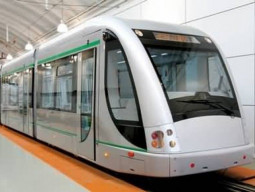
LAHORE:
Ever since Muhammad Saddiq’s two-storey house in Northeast Lahore was demolished on New Year’s Day to make room for the Orange Line metro train project, he has been living with his wife and four grown-up children in a single-room apartment allocated by the government. Saddiq was finally able to apply for relocation compensation two weeks ago, but remains unconfident of the prospects.
“I’m worried about how much I could get back without proper documents,” said Saddiq, 60, who delivers dispatches at Pakistan Railways. “The authorities are saying Rs150,000 per marla, but it should be double that amount.”
Funded by a state-owned Chinese bank, the metro train project is expected to boost the city’s economy and reduce air pollution. Yet, the Orange Line has been arousing controversies surrounding compensation for residential and commercial relocation and protection of historical buildings, further complicated by the power struggle between Pakistan Muslim League Nawaz and opposition parties.
Residents and business owners requested to relocate from the train route are struggling with lack of housing documents, potential inadequate compensation due to under-declared property for tax evasion, and the headache to find a new home or build up goodwill from scratch.
The provincial government is expected to pay Rs20 billion in compensation for land acquisition to approximately 2,300 households and businesses.
The compensation package based on the so-called surveyor’s price backed by State Bank of Pakistan includes a 15% compulsory acquisition premium, 10 to 12% displacement allowance, and other compensation for business loss and structure material, according to Khawaja Ahmad Hassan, a senior PML-N leader with a strong candidacy for Lahore’s next mayor.
“I’ve heard no complaint about land acquisition,” said Mohammad Pervaiz Malik, PML-N’s Lahore President, who recently visited a compensation camp near University of Engineering and Technology. “Nobody’s property was acquired before compensation, and no one was denied compensation.”
However, many architects and experts in culture and history have voiced their opposition to the Orange Line construction, fearing inevitable and irreversible damage to historical sites. They have called on the government to stop and review the project, and put the Orange Line under public scrutiny.
“By the time the construction is finished, the city of Lahore will be gone,” lamented Kamil Khan Mumtaz, an architect and founding member of Lahore Conservation Society. “The significance of a historical site or building is not just its physical structure but also the context. The construction is now destroying the view and ambiance.” Mumtaz said the construction had already destroyed or affected 16 historical sites or buildings, including a McLeod Road milestone marking the distance between Lahore and Delhi.
Hassan of PML-N, on the other hand, maintained nothing is threatening historical sites along the Orange Line corridor. “We’ve gone through tests and utilized special techniques for construction and civil works, which made the construction almost vibration proof,” he said. “A German expert said ‘it’s even below the minimum level of vibration.’”
But Mumtaz refuted the authorities’ tests, questioning the methods of those examinations. “You should take into consideration the rolling stock, the weight, the acceleration, etc,” he said. “We need public transportation, but we should not destroy our city.”In an opposition alliance protest on The Mall in front of the Punjab Assembly earlier, protesters voiced their demands including constructing the project underground instead of using elevated tracks, relocation compensation at market value plus a 25% premium, and no diversion of social project funds to the Orange Line construction.
A major challenge for the ruling PML-N is to not let these local protests escalate into strategic and nationwide unrest, according to Andrew Small, a policy researcher at the German Marshall Fund of the United States in Washington, DC. “It’s much more difficult and challenging than managing street-level protests to deal with Punjab-related issues on the national stage concerning political and economic topics,” added Small, whose book, The China-Pakistan Axis: Asia’s New Geopolitics, delves into the relationship between the two countries.
But for Saddiq’s wife Shamshad Akhtar, a 50-year-old housewife, it’s her three unmarried daughters’ future that’s been on her mind. With their house demolished and no new nest for the family in the near future, it’s difficult for the girls to find good matches without a “real estate leverage” on their side.
“I don’t want money but a new house for our family,” Akhtar said as they were waiting to apply for compensation with her husband and son. “I’m really disappointed, and I don’t know what to say or what we’re going to do next.”
Harvard Zhang is a special correspondent. Staff writer Imran Adnan in The Express Tribune’s Lahore bureau contributed to this report.
Published in The Express Tribune, February 17th, 2016.














































COMMENTS
Comments are moderated and generally will be posted if they are on-topic and not abusive.
For more information, please see our Comments FAQ